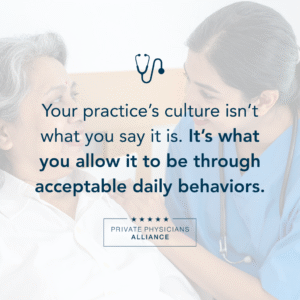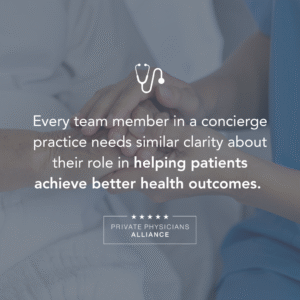Most entrepreneurial physicians focus on clinical protocols and operational systems when building their concierge practices. What if exceptional patient experience has less to do with procedures and more to do with something harder to measure?
At Private Physicians Alliance’s recent annual meeting, keynote speaker Susan Salgado delivered this thesis: Culture drives brand. Without a strong internal culture, even the best training programs fall short.
What “Culture Drives Brand” Means for Concierge Medicine
Your practice’s culture isn’t what you say it is. It’s what you allow it to be through acceptable daily behaviors.
For physicians running membership medicine practices, your reputation is directly shaped by how your team interacts with patients every single day, not by your mission statement or marketing materials.
Acceptable behavior defines culture, regardless of stated values. When we ignore bad behavior, that becomes our culture.

Why Five-Star Hospitality Requires Cultural Groundwork First
Training staff on service protocols only addresses the technical side of their jobs.
Susan distinguishes between technical skills (how to do the job) and emotional skills (making people feel cared for). Creating checklists and standard operating procedures addresses only half the equation.
Susan shares an example from her work with Danny Meyer’s Union Square Hospitality Group: She never thought she’d have to tell a hostess to smile at the front door of a restaurant.
People aren’t all wired the same way. Without cultural groundwork that helps people understand the impact of their behaviors, training falls flat. When team members understand how their actions affect patients (smile at people, and they feel welcomed and become nicer to you in return), the behavior becomes purposeful.
What Strong, Intentional Culture Looks Like
A strong culture has concrete, observable elements that staff and patients experience daily.
Shared Cultural Language
Susan introduces the concept of creating shorthand that reminds staff of expectations in real time. She references Danny Meyer’s phrase “curtain up, curtain down”: when the curtain is up and patients are present, conversations focus on patient health, not internal issues.
One simple phrase can redirect behavior. When someone starts having a private conversation in earshot of a patient, a colleague can quietly say “curtain up,” and everyone understands.
This cultural language creates accountability without confrontation. It becomes a tool teams use to maintain standards even when leadership isn’t present.
The Swan Principle: Grace Under Pressure
Susan uses the swan metaphor to illustrate how practices should appear to patients. A swan moves across water with elegance. Underneath the surface, it’s paddling frantically.
In practices where this principle takes root, when daily operations get chaotic, the team maintains composure for patients and efficiently solves problems behind the scenes.
Everyone Understands Their Role in Patient Outcomes
William Cooper, a shuttle bus driver at Boston Children’s Hospital, says his job is helping kids get better. He’s not just transporting people from point A to point B.
This perspective changes how he shows up for work. He becomes the person with the right knock-knock joke for a scared child or the calming word for a terrified parent.
Every team member in a concierge practice needs similar clarity about their role in helping patients achieve better health outcomes. The front desk staff isn’t just scheduling appointments. They’re often the first voice a worried patient hears.
Zero Tolerance for Toxicity
When you ignore bad behavior, you allow it to continue. Your best employees notice and become demoralized, especially if they’re earning the same salary as someone who isn’t meeting standards.
Staff members discuss these disparities with one another. Allowing toxic behavior or poor performance to persist sends a message about what you value.

How Culture-First Thinking Changes Hiring and Onboarding
A culture-first approach changes how practices evaluate candidates and integrate new team members.
The traditional hiring process focuses heavily on technical qualifications: Do they have the right certifications? Have they worked in a medical practice before? Can they perform the required tasks?
These questions matter, but they’re insufficient. Culture fit means hiring people who can see beyond their job description to understand their impact on patient outcomes.
The window washers who dressed as superheroes at Cleveland Children’s Hospital changed their role from maintenance work to caregiving. They recognized that frightened children watching them work from hospital beds needed moments of joy, and they created those moments.
That kind of awareness and initiative can’t be taught if someone lacks the basic disposition for it. It must be present in candidates from the start and then nurtured through onboarding.
Explicit Communication of Expectations
People can’t read your mind. You can’t expect everyone to naturally understand what you believe in, what you’re looking for in the patient experience, or how you expect them to behave with one another.
Practices must explicitly articulate behavioral expectations during the interview process and throughout onboarding. What does excellent patient care look like in your practice? How do team members support each other during high-stress periods? What behaviors are non-negotiable?
Making Culture Concrete From Day One
New team members must learn your cultural language (whatever equivalent of “curtain up” or “swans” you’ve developed) during their first week. Tell stories about times when team members went above and beyond and why those moments mattered.
They should understand consequences. What happens when someone doesn’t meet cultural standards? How does the practice address conflicts or performance issues?
Making Standards of Excellence Stick: The “Why” Behind the “What”
Private Physicians Alliance provides members with a Standards of Excellence checklist that outlines essential elements for delivering exceptional patient experiences. Susan’s framework provides the “why” that makes these standards meaningful rather than mechanical.
Consider the challenge of teaching luxury service expectations. When patients pay thousands of dollars for a membership, expectations naturally rise. What does meeting those expectations look like in daily interactions?
Susan’s approach addresses this expectation by helping teams understand the impact of their behaviors, not just the behaviors themselves. A checklist might say, “Greet patients warmly within 30 seconds of arrival.” Susan’s framework helps staff understand why that matters: When patients feel welcomed immediately, their anxiety decreases, they’re more likely to be open during their visit, and the appointment becomes more productive.
Making Subjective Standards Objective
One of Susan’s key contributions is showing how to make emotional skills as objective as technical skills. It’s easier to correct someone’s filing system than to address their attitude or lack of warmth.
The solution is describing what you see and what you need to see, like a movie director: “What I’m seeing you do is speak in a monotone and barely make eye contact with patients. What I need you to do is make eye contact, use a warm tone, and pause to make certain they feel heard. When you do that, patients will feel cared for, and you’ll likely find they’re more cooperative and appreciative.”
This approach removes the defensive response that comes from feedback that feels personal. It makes emotional skills as trainable as technical skills by focusing on observable behaviors and their impact.
Creating Accountability Systems
The Standards of Excellence checklist becomes more effective when combined with Susan’s cultural language approach. Teams can reference specific standards in real time: “Remember, we’re aiming for swan-level calm during afternoon appointments.”
These references create peer-to-peer accountability. Culture becomes a foundation that the team maintains together, not an afterthought that requires constant management oversight.
The Single Most Important First Step
Articulate what you believe in and expect, then communicate it to your team.
Most practices operate on assumptions. They assume team members understand the practice’s values, know what exceptional service looks like, and recognize which behaviors align with the practice’s mission. These assumptions rarely prove accurate.
The work begins with clarity. What do you want your culture to be? Define specific expectations:
- How should team members greet patients?
- What tone and language should they use?
- How should they handle mistakes or difficult situations?
- How should they support each other during challenging times?
- What behaviors are unacceptable?
The Follow-Through That Defines Culture
Articulating expectations is necessary but insufficient. Address behavior that doesn’t align with the stated culture immediately and consistently.
When you ignore misaligned behavior, you project that what you say doesn’t matter. Your culture becomes defined by what you tolerate, not what you aspire to.
Your best team members notice when someone treats patients dismissively or creates drama without consequences. They’re asking themselves why they should maintain high standards when others don’t have to.
Building Culture That Drives Your Brand
Clinical excellence and operational efficiency aren’t enough to create the exceptional patient experience that defines successful concierge practices.
Culture is what either amplifies or undermines everything else. It’s the difference between a team that makes patients feel genuinely cared for versus one that follows protocols mechanically. It’s what determines whether your practice thrives during growth or begins to fray as complexity increases.
Access Your Standards of Excellence Resources
Private Physicians Alliance has developed Standards of Excellence for company culture and five-star hospitality. These resources provide the practical framework for implementing the cultural principles discussed above.
Members can access these standards, along with implementation guides and assessment tools, through the Private Physicians Alliance app. For practices ready to go deeper, Private Physicians Alliance has partnered with Susan Salgado and Business Training Works to provide culture assessment and training services tailored specifically for concierge and membership medicine practices.
To learn more about Private Physicians Alliance membership, visit PPA.health, or reach out to our membership team to discuss how we can support your practice’s culture development.